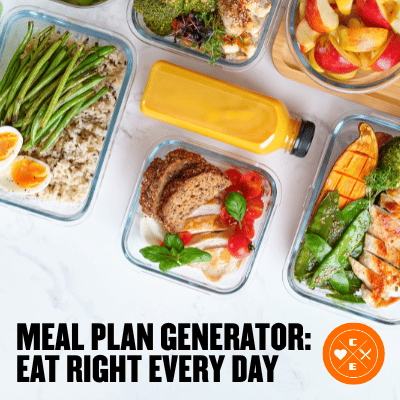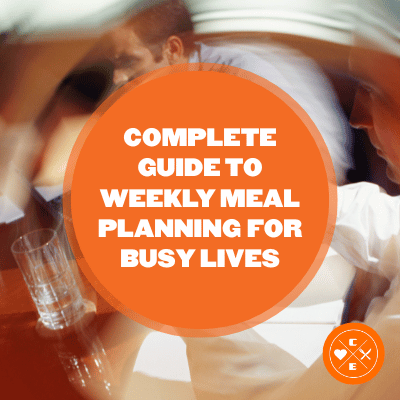How to Stick to Your Meal Plan When Life Gets Busy

Jason Nista
Nutrition
09/11/2025 1:53pm
7 minute read
Table of Contents
How to Stick to Your Meal Plan When Life Gets Busy
Meal planning holds the promise of healthier eating, minimized food waste, and saving both time and money. Yet, even the most well-intentioned meal planners can find themselves veering off course. Life is unpredictable - busy schedules, fatigue, last-minute plans, or simply not feeling up to cooking can derail even the best-laid plans. But here’s the truth: meal planning isn’t about perfection. It’s about finding systems that work for your life, allowing for flexibility while sticking to your goals.
This guide will walk you through the major challenges of sticking to a meal plan and offer practical, adaptable strategies to help you succeed - even on your busiest days.
Why Sticking to a Meal Plan Can Feel So Hard
Many of us start the week feeling optimistic. We plan a week of delicious, nutritious meals with the intention of staying organized and prepared. But by midweek, exhaustion creeps in, and takeout suddenly seems like the easier option. While this scenario is common, it’s often the result of overly rigid planning, underestimating life’s unpredictability, or not accounting for personal preferences and schedules.
Here are some common reasons meal plans fail and how to address them:
1. Planning Too Rigidly
- The Problem: Scheduling meals for every single night without leaving room for flexibility often leads to burnout. Life happens - schedules shift, plans change, and energy levels fluctuate.
- The Solution: Plan fewer meals (e.g., 3-4 dinners) during the week instead of seven. Leave space for leftovers, takeout, or spontaneous plans. If your week frees up, you can always add more meals.
2. Forgetting to Factor in Your Schedule
- The Problem: Not aligning meal prep with your busiest days can lead to skipping meals or reaching for convenience foods.
- The Solution: Look at your calendar when planning meals. Got a late meeting or soccer practice? Opt for a slow-cooker meal, freezer-friendly leftovers, or a 15-minute dinner on those nights.
3. Not Involving Your Family
- The Problem: If your family isn’t excited about the meals you’ve planned, resistance to eating those meals could throw things off track.
- The Solution: Get your family involved in the planning process. Ask for their input or rotate their favorite meals into the schedule. Bonus: tag recipes as "family favorites" so you can easily revisit them.
4. Following Someone Else’s Meal Plan
- The Problem: Generic meal plans found online may not match your lifestyle, dietary needs, or preferences.
- The Solution: Customize your meal plan to suit your preferences. Start by using ingredients you already have and plan meals that fit your family’s tastes and schedule.
Strategies for Consistent Meal Planning
1. Plan Around Your Real Life
Start by evaluating your week. What nights are you most likely to feel too tired to cook? Which days are hectic and require easy or pre-prepared meals? Use this information to guide your planning.
- Busy Days: Rely on crockpot meals, freezer-friendly options, or leftovers.
- Flexible Days: Experiment with new recipes or elaborate dishes when you have more time.
2. Scale Back Your Plan
Overplanning is one of the biggest reasons meal plans fail. Stick to planning 3-4 dinners per week instead of trying to cover every single day. This approach leaves room for flexibility without wasting ingredients.
- Example: Plan meals for Monday, Tuesday, and Thursday. Use Wednesdays for leftovers or pantry meals, and leave Friday open for takeout or an impromptu meal.
3. Build in Quick Wins
Incorporate meals that are easy to prepare or require minimal cleanup. Some ideas include:
- Breakfast for dinner (e.g., scrambled eggs, pancakes, or breakfast burritos)
- Pre-made freezer meals like lasagna or enchiladas
- 15-minute dinners like stir-fries or tacos
4. Rotate Family Favorites
Keep a list of 8-10 tried-and-true recipes your family loves. Rotate these into your meal plan regularly, and sprinkle in one new recipe every week or two for variety.
- Example Family Favorites: Spaghetti and meatballs, tacos, chicken stir-fry, or shepherd’s pie.
5. Create Theme Nights
Assign a theme to each night of the week to make planning easier. For example:
- Meatless Monday: Veggie stir-fry or lentil soup
- Taco Tuesday: Ground beef or fish tacos
- Freezer Friday: Reheat pre-made meals like soups or casseroles
6. Use What You Already Have
Before planning your meals, take inventory of your pantry, fridge, and freezer. Challenge yourself to get creative using what’s on hand. For example:
- Have canned chickpeas and coconut milk? Make a quick curry.
- Got leftover veggies? Toss them into a stir-fry or frittata.
How to Handle Meal Plan Fatigue
Even the best meal planners can experience burnout or lose the enthusiasm to cook. Here’s how to push through:
1. Have Backup Meals Ready
Always keep a few backup meals on hand for nights when cooking feels like a chore. These could include:
- Frozen meals you’ve prepped ahead of time (e.g., white chicken chili, enchiladas)
- Pantry meals like pasta with jarred sauce or canned soups
- Quick staples like grilled cheese and soup
2. Stay Flexible
Life doesn’t always go as planned, and that’s okay. If you’re not feeling a particular meal, swap it with another on your plan or save it for later in the week. Remember, adaptability is key.
3. Check In with Your Plan
Make a habit of reviewing your meal plan each morning. This gives you time to thaw ingredients, adjust your schedule, or rethink a dinner choice.
4. Focus on the Big Picture
Meal planning is a tool to reduce stress, not create it. If you end up ordering takeout one night, don’t beat yourself up. Tomorrow is a fresh start.
Why Consistency Is Key
Building a meal planning habit takes time, but consistency is what makes it stick. Just like any habit - going to the gym, journaling, or even cleaning the house - there will be days when you don’t feel motivated. But the benefits of sticking to your plan outweigh the temporary inconvenience.
By investing a little time and effort upfront, you’ll feel the rewards throughout the week: less stress, healthier meals, and more time for the things you love.
Key Takeaways
- Plan Realistically: Schedule 3-4 meals per week to avoid burnout and leave room for flexibility.
- Use Theme Nights: Assign themes like Taco Tuesday or Freezer Friday to streamline planning.
- Focus on Favorites: Rotate tried-and-true recipes and sprinkle in new ones for variety.
- Keep Backup Meals Ready: Stock your freezer and pantry with quick options for busy nights.
- Adapt to Change: Life happens - pivot when needed and stick to your plan the next day.
- Check Your Schedule: Align meal prep with your calendar to avoid planning complex meals on busy days.
- Take Inventory: Use pantry and freezer staples before buying new ingredients.
- Lower Stress: Meal planning isn’t about perfection - it’s about making life easier. Be flexible and stay consistent.
Meal planning doesn’t have to feel overwhelming or restrictive. With a little flexibility and the right strategies, you can create a system that works for your unique lifestyle. Remember, it’s not about achieving perfection but building a habit that simplifies your life. Stick with it, and soon enough, meal planning will feel second nature. Happy planning!
Source: "#114: How to Stick to Your Meal Plan (Even When Life Gets Busy)" - Plan to Eat, YouTube, Aug 27, 2025 - https://www.youtube.com/watch?v=JGrsv9193pI
Use: Embedded for reference. Brief quotes used for commentary/review.
Related Articles
Meal Plan Generator: Eat Right Every Day
5 minute read
Complete Guide to Weekly Meal Planning for Busy Lives
6 minute read



